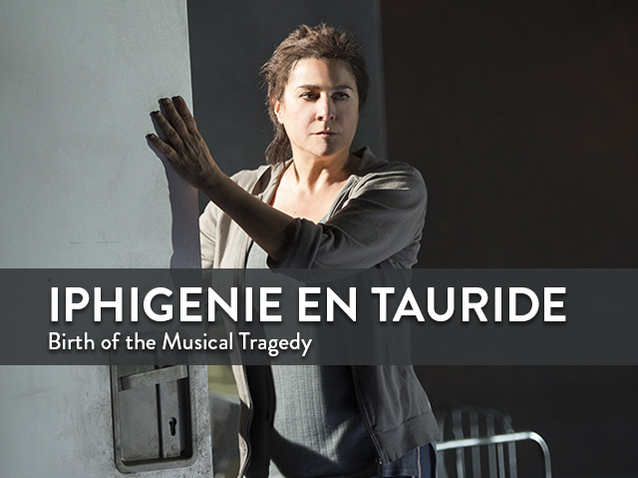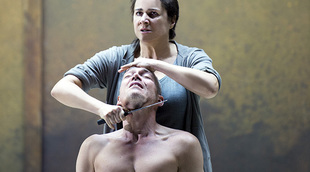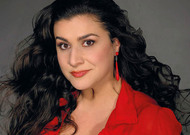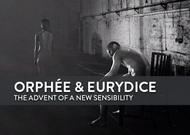 © DR
© DR
Cecilia Bartoli is reviving Gluck’s Iphigénie en Tauride for the Salzburg Whitsun Festival. As we eagerly await this new interpretation (which we know will be very erudite and documented) in a new production, we take a look back at the work itself, mid-way between opera and theatre, and its historical context, marked by the advent of Romanticism at the expense of opera seria.
***
Iphigénie en Tauride, Gluck’s last Parisian triumph, is part of the lively quarrel between the “Gluckists” and the “Piccinists”.Fans of the Neapolitan composer Niccolo Piccini (1728-1800) praised the superiority of Italian opera over French opera, which Gluck and his admirers considered “the true dramatic musical genre”.The two rival composers squared off over a very popular subject, often exploited, whether by Campra, Scarlatti or Jomelli, to cite only the better known authors.The fate of Iphigenia, daughter of Agamemnon and Clytemnestra, abounds in dramatic conflicts and moving situations likely to arouse terror and emotion in the audience Gluck was addressing.His aesthetic reform of opera corresponds to a disruption in the sensibilities announced and ardently encouraged a few years earlier by Jean-Jacques Rousseau and Denis Diderot.Seeking simplicity and naturalness in the lyrical expression of feelings, Gluck turned away from the complicated plots and vocal prowess of “opera seria” to open the gates of Romanticism.With this new work, audiences seemed to rediscover a taste for theatre, as Baron Brimm put it so well in his Literary Correspondence:“When I hear Iphigénie, I forget I am at the opera; I think I am, listening to a Greek tragedy (…).”I don’t know if that is singing, but perhaps it’s much better.”
From One Tempest to Another
This aesthetic quarrel pitting “Gluckists” against “Piccinists” went through another lively episode with the staging of Iphigénie en Tauride on 18 May 1779 at the Royal Academy of Music, ancestor to the Paris Opera.This much-anticipated first performance was a dazzling triumph that could not be denied, and this has kept the work in the repertoire right down to our day.“There isn’t just one beautiful piece in ‘Iphigénie en Tauride, it’s the whole work”, as we read in Le Mercure de France on 5 June 1779. Together with Orphée et Eurydice (1762), it became Gluck’s most popular work.For the first and only time, Gluck and Piccini faced off on a common subject that had already been adapted many times.When the two musicians decided at the same time to take an interest in the moving story of Agamemnon’s daughter, they did not yet know that they were about to play out the last act of this quarrel, which from 1777 to 1779 unleashed a storm of discussion, articles and lampooning in every genre.How today can we understand the importance of these aesthetic wars that pit philosophers, poets and musicians against one another?At a time when so few of our contemporaries seem concerned with cultural issues, it is indeed difficult to imagine such intellectual effervescence over music. That said, we can guess that the violence of the clashes characterising these debates can be partly explained by the political situation at the time.Under the Ancien Régime, discussions could be unreservedly passionate so long as they remained in the cultural domain and did not lead to an open challenge to power.Supporting a given artist was a roundabout way of opposing or rallying behind the King who, by patronising the arts, promoted an official art. Both the Gluckists and the Piccinists repeatedly reversed their stands as a result of political influences.Austrian Empress Maria Theresa had appointed Maestro Gluck to see to her children’s musical education, especially that of Marie Antoinette.That is why all of the supporters of Marie Antoinette, who became dauphine and then Queen of France, were fervent Gluckists, whereas the Piccinists included all her detractors: Marmontel, d’Alembert and Madame du Barry.
Gluck was nonetheless responsible for a decisive change in how lyrical dramatic art is conceived.His operas that follow the principles inspired by his great reform are less numerous – but the most performed and most admired, as demonstrated by the analyses of Richard Wagner or the enthusiasm of Hector Berlioz, who was fascinated by the innovative genius of a contradictory oeuvre positioned at the turning point between two eras.
The major stages in Gluck’s career, which unfolded in the Europe of the Enlightenment, provide an exciting opportunity to enquire into concepts that are essential for opera lovers. The real turning point in Gluck’s career came with a decisive encounter with an Italian scholar attracted by the new aesthetic concepts introduced by Diderot and Rousseau, librettist Raniero di Calzabigi (1714-1795), whose ambition was to change opera. With the help of this brilliant theoretician, Gluck set off on an ambitious reform of lyrical drama.New demands led him towards a sensitive expression of emotive feelings.Gluck sought greater simplicity in dramatic action, more naturalness in singing freed from virtuoso ornamentation.In 1762, Gluck and Calzabigi presented Orfeo et Euridice at the Burg-Theater in Vienna. This was the first attempt at the “opera reform” advocated by Gluck, who until then remained an “Italian”, even though his approach to French comic opera opened up new prospects for him.The reformist composer pursued his goal, clearly announcing his plan in the preface to Alceste (1767). The dedicatory epistle to the Duke of Tsucany, which serves as preface to this manifesto, explains the choices that guided the composer: “I have sought to reduce music to its true function, which consists of supporting poetry so as to strengthen emotional expression and the impact of dramatic situations without interrupting the action and without weakening it with superfluous ornamentation.”This new requirement, which calls into question the supremacy of the virtuosity so valued in bel canto, seeks to promote a stylised musical expression that incorporates the natural inflexions of the spoken language. Singing, as an expression of characters’ innermost feelings, must respect the need to develop a tight plot.All these “opera seria” excesses began to clash with the tastes of an evolving audience in the second half of the 18th century.With Gluck, who defined his music as “the language of humanity”, opera would leave behind the tyrannies of musical hedonism to become a lyric drama in which the truth of passion was expressed as naturally as possible.
In 1777, the Paris musical was once again in flux:Armide, composed on a libretto by Quinault, brought to a climax a poisonous quarrel in the Parisian press between partisans of the new French opera and fans of traditional Italian opera.The Gluckist contingent faced off against the Italianising contingent, which championed a very good Italian composer, Niccolo Piccinni.The two implicated musicians actually respected each other greatly and never clashed.
A Reformer’s Coronation
With this Iphigénie en Tauride, the musician-theoretician achieves a decisive triumph, applying the great principles of his operatic reform, but the failure of his next work, Echo et Narcisse, convinced him to leave France for Vienna some months later.The famous quarrel ended, and in 1781 the twin work of his rival Piccini was performed to a politely indifferent audience.Crowned with glory and enjoying immense prestige, Gluck died in Vienna on 15 November 1787, two weeks after Mozart’s Don Giovanni debuted in Prague.

The “aesthetic tempest” set off by the efforts of an indefatigable reformer seem echoed by the tempest that opens Iphigénie en Tauride.It announces another opening comparable to that of Verdi’s Otello (1887), in which the elements are also unleashed ominously as the drama begins.The same gripping start, “in medias res”, more than a century later (although we don’t know whether Busseto’s maestro was inspired by his daring predecessor).At the start of Die Walküre (1870), Wagner, a great admirer of Gluck’s, recalls this peaceful opening suddenly interrupted by the unleashing of the strings.This powerful opening is one of the loveliest inventions of Iphigénie en Tauride.French lyric tragedies contain more than one noteworthy storm, but not as a “prelude”.The chaos of the elements approaches little by little, and Iphigénie is in turmoil. A perfect illustration of what Gluck theorised: “I imagined that the Overture should warn the audience about the nature of the action they are about to see, and tell them what the subject is: that the instruments should be played only in proportion to the level of interest and passion”.The libretto features a constant dramatic tension, a desire to strike the imagination by exploiting the key elements of a very tight plot.The storm raging right from the overture plunges us suddenly into the ambience of a “diabolically human” work, as Goethe put it.This storm, the template for all future operatic storms, stylishly opens the gates of romanticism.The orchestra becomes a true protagonist, ensuring the drama’s continuity.This search for musical continuity, which ensures dramatic tension, is a major contribution.Everything has to contribute to a single goal:touch and move the audience by a faithful depiction of the passions that stir the protagonists.The subjugated spectator will understand that the unleashing of Nature was on a par with the nightmare that Iphigénie is going to describe.The drama began for her in the form of a terrible dream, before the curtain rose.
It is quite rare in art history for a work so resolutely original and innovative should meet with such approval by managing to reconcile critics and the public in their admiration and enthusiasm.Iphigénie en Taurideliterally subjugates its listeners and disarms the reformer-musician’s opponents.On the day after the premiere, Le Mercure de France wrote: “Never has opera made such a strong and so widespread an impression on the public.Extreme, uninterrupted attention; the liveliest emotion expressed on every face, and empathy taken to the point of tears; applause elicited by admiration (…)these were the signs of unequivocal interest and approval, more flattering than a mere clapping of hands driven by the cold infatuation of self-esteem and partisanship”.A harbinger of Romanticism, Gluck’s work was included in the Paris Opera repertoire until the eve of the 1830 Revolution.
Such enthusiasm is all the more extraordinary in that the libretto by Nicolas-François Guillard eliminated any trace of amorous intrigue, thereby perfectly meeting the composer’s expectations.The action focuses on three characters: Iphigénie, Oreste and Pylade.The powerful bonds of friendship linking Oreste to Pylade, and the fraternal love of Iphigenia determined to protect Oreste against all dangers, are the drama's essential drivers.We no longer find any of those gallant rivalries that were the highlight of lyric tragedy.Another noteworthy innovation:Gluck, fond of verisimilitude, kept only one ballet, the “Dance of the Scythes”, which fits perfectly into the action.
Towards New Emotions

The ideal of emotional truth, backed by the search for natural simplicity in sung expression, is achieved in Iphigénie en Aulide, created in Paris in 1774 with support from Queen Marie Antoinette.This “opera tragedy” whose libretto is adapted from Racine’s Iphigénie ensured the triumph of the composer who settled in Paris.But Gluck went even further with Iphigénie en Tauride, which he dedicated to his patron, Marie-Antoinette.Iphigénie’s sacrifice inspired many playwrights and musicians after Euripides, who twice chose the touching girl as heroine:in 406 BC in Iphigenia in Aulis and in ca. 414-412 in Iphigenia in Tauris.The sacrifice of an innocent victim demanded by the imperatives of the Trojan War does not appear in Homer but dates back to Stasinos of Cyprus, a poet of the 7th century BC.Iphigenia is to be burned alive by her father Agamemnon, head of the Greek army, to enable the boats stalled at Aulis to head for Troy where the beautiful Helen is being held.They clash over the fate of the unhappy girl, who is defended by her mother, Cytemnestra.Without going into detail on the various versions favoured by each author, we will look at the scenario in which Iphigenia reappears in Tauris after having been sacrificed for the success of the expedition against Troy.She has become the priestess to Artemis, who took her away to the far-off land of the Scythes.Going from victim burned at the stake to high priestess, Iphigenia must now assent to the demands of a bloody cult:to sacrifice any outside who lands on the ill-fated shore where she is exiled. Her brother Oreste, whom she believes is dead, arrives by chance in Tauris, accompanied by his friend Pylade.
Gluck’s masterpiece took the basics of this story and dramatized it.The young poet Guillard understood that his libretto needed to reconnect with the power of the Greek tragedies. However, he introduced two scenes that increased the emotion tenfold with their powerful musical impact:the initial storm, followed by the story of the frightful nightmare, and, in Act 2, the choir of the Eumenides disturbing Oreste’s sleep.The scene featuring Oreste’s recognition during the immolation ceremony, like the intense feeling of guilt that is torturing this murderous son, places us forcefully in the core of tragedy, accentuating the emotional power of situations already present in Euripides.The choice of a happy denouement enables Iphigénie, finally appeased, to return to the shores of her native Greece.Sentenced to die at the stake by the priestess for having killed her mother, Clytemnestra, Oreste will be authorised by Diana to go back to Mycenae with Iphigénie to reign there.
With Iphigénie en Aulide, Gluck’s contemporaries seem to rediscover the pleasure of the theatre, as is noted by Le Journal des sciences et des arts : “Iphigénie en Tauride” seems to have convinced the public of the possibility of combining the strict rules of dramatic poetry with the harmony of singing and made them believe that one can go to the opera for verses”.By realising the ideal of Greek tragedy, the opera that became a perfect synthesis of music and poetry appears to be the “total spectacle” that Wagner was to dream of several decades later.Music in the service of drama.Gluck proclaims it unequivocally: “I thought that most of my work should be reduced to seeking a beautiful simplicity, and I avoided showing off with difficult parts at the expense of clarity; I attached no value to the discovery of something new unless it was given naturally by the situation and linked to expression; ultimately, there was no rule I thought I had to sacrifice willingly in favour of the effect”.
The Parisian public’s reception of the work in 1779 shows that they understood it immediately.Midway between opera and theatre, Iphigénie en Tauride elicits new emotions in keeping with the sensibilities of the period.The search for what is simple and natural guided the composer, who responded to Europe’s enthusiasm for an idealised Greece, symbol of a return to the source.Herculaneum was rediscovered in 1755. In 1764 the Histoire de l’art antique by Winckelmann (1717-1768) was published; it was an essential work in the emergence of Neo Classicism.Gluck might have said of Iphigénie en Tauride what he said earlier about Alceste (1767): “It should not be popular only now and as something new; there’s no time for it; I can state that it will also be popular two hundred years from now (…)And my reason is that I laid all the foundations in nature, which is never subject to fashion”.The last word goes to Saint-Saëns, who said of Gluck that he was “neither pompous nor solemn” but was “life, passion, dramatic feeling at its most intense”.
Catherine Duault
Read also
Portrait : Cecilia Bartoli back in Salzburg
Cecilia Bartoli has had several careers.Since she set out to conquer the opera world twenty-five years ago, the Mozart and, especially, Rossini specialist has turned into an explorer of forgotten repertories...
Read more...





Comments